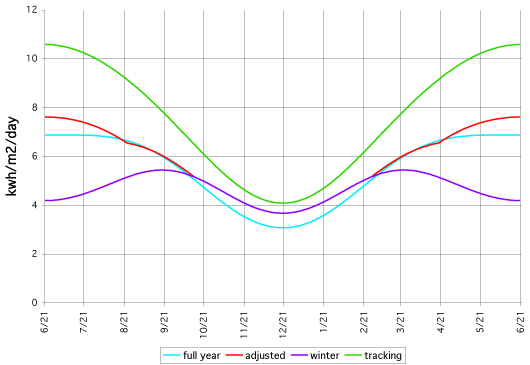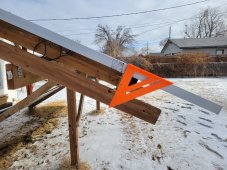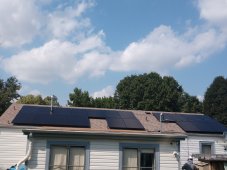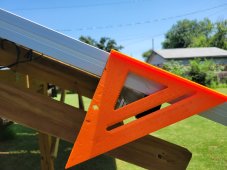For a ground-mount PV rack... What if every month or two, at roughly noon (solar or clock) I went out to my panel rack with a [paper-towel tube, wood dowel, pencil, etc] and stood it up 90-deg against a panel face, then adjusted until there was minimal-to-no shadow? Good enough or no?
You are using an out of date browser. It may not display this or other websites correctly.
You should upgrade or use an alternative browser.
You should upgrade or use an alternative browser.
How to correctly measure for solar angles for DiY design and build
- Thread starter JohnLM
- Start date
PreppenWolf
Solar Addict
- Joined
- Oct 10, 2022
- Messages
- 927
For a ground-mount PV rack... What if every month or two, at roughly noon (solar or clock) I went out to my panel rack with a [paper-towel tube, wood dowel, pencil, etc] and stood it up 90-deg against a panel face, then adjusted until there was minimal-to-no shadow? Good enough or no?
Yes just as good. I would say once every 3 months would be adequate.
I’ve been using the Sunnytrack app on my iPhone. It uses your location and phone’s camera. Looking through your phone’s camera there’s a superimposed path of the sun for current day, winter and summer solstices or any day you choose. You stand at your potential panel location and you can see if you have obstacles that aren’t anticipated in your initial observations. Just wish I had it a year ago.
jasonhc73
Cat herder, and dog toy tosser.
For a ground-mount PV rack... What if every month or two, at roughly noon (solar or clock) I went out to my panel rack with a [paper-towel tube, wood dowel, pencil, etc] and stood it up 90-deg against a panel face, then adjusted until there was minimal-to-no shadow? Good enough or no?
I haven't been able to put the December Equinox yet because of clouds.
I have each month on the first and summer solstice marked(just no photo).
Attachments
Hedges
I See Electromagnetic Fields!
- Joined
- Mar 28, 2020
- Messages
- 20,680
Seems to me your April, May, June marks (if that's what those are) are so close in angle that adjusting tilt doesn't matter.
Some people say 2 adjustments per year would be adequate.
Obviously time of day spans a larger angle, but then would need some kind of tracker.
I'm working toward at least two fixed orientations wired in parallel. Originally aimed at 2:00 PM due to previous time of use schedule, have now added some West facing due to later peak times of new schedule. May later add some to catch morning sun - off peak but no lower rate than early afternoon. Flatter production curve.
Panels once cost me $5/W, recently $0.15/W.
Some people say 2 adjustments per year would be adequate.
Obviously time of day spans a larger angle, but then would need some kind of tracker.
I'm working toward at least two fixed orientations wired in parallel. Originally aimed at 2:00 PM due to previous time of use schedule, have now added some West facing due to later peak times of new schedule. May later add some to catch morning sun - off peak but no lower rate than early afternoon. Flatter production curve.
Panels once cost me $5/W, recently $0.15/W.
sunshine_eggo
Happy Breffast!
I believe this guy:
In short, adjusting the tilt twice a year gives you a meaningful boost in energy. Adjusting four times a year produces only a little more, but could be important if you need to optimize production in spring and fall. You can jump to the section on the best fixed tilt angle, or skip to the sections on two-season or four-season adjusting.
The graph below shows the effect of adjusting the tilt. The turquoise line shows the amount of solar energy you would get each day if the panel is fixed at the full year angle. The red line shows how much you would get by adjusting the tilt four times a year as described below. For comparison, the green line shows the energy you would get from two-axis tracking, which always points the panel directly at the sun. (The violet line is the solar energy per day if the panel is fixed at the winter angle, discussed below.) These figures are calculated for 40° latitude.

+4.2% to adjust 2X per year + another 0.5% to adjust 4 times per year... I can't imagine it's going to be more than another 0.5-1% if I'm being generous.
I made my mounts with summer, fall/spring and winter settings. What I've noticed is that panel temps pretty much even things out. My best is in mild spring/Fall days where my panels are mostly tilted optimally. Summer gets more total insolation, but the cells are near the NOCT rating, and my output is down.
Here's my Winter Solstice output:

That's 89% of rated.
I'm just too lazy to make those changes for just a smidge of an improvement.
Fixed or Adjustable?
It is simplest to mount your solar panels at a fixed tilt and just leave them there. But because the sun is higher in the summer and lower in the winter, you can capture more energy during the whole year by adjusting the tilt of the panels according to the season. The following table shows the effect of adjusting the angle, using a system at 40° latitude as an example. (The comparison would be a little different for different latitudes.) Each option is compared with the energy received by the best possible tracker that always keeps the panel pointed directly at the sun.| Fixed | Adj. 2 seasons | Adj. 4 seasons | 2-axis tracker | |
| % of optimum | 71.1% | 75.2% | 75.7% | 100% |
The graph below shows the effect of adjusting the tilt. The turquoise line shows the amount of solar energy you would get each day if the panel is fixed at the full year angle. The red line shows how much you would get by adjusting the tilt four times a year as described below. For comparison, the green line shows the energy you would get from two-axis tracking, which always points the panel directly at the sun. (The violet line is the solar energy per day if the panel is fixed at the winter angle, discussed below.) These figures are calculated for 40° latitude.

+4.2% to adjust 2X per year + another 0.5% to adjust 4 times per year... I can't imagine it's going to be more than another 0.5-1% if I'm being generous.
I made my mounts with summer, fall/spring and winter settings. What I've noticed is that panel temps pretty much even things out. My best is in mild spring/Fall days where my panels are mostly tilted optimally. Summer gets more total insolation, but the cells are near the NOCT rating, and my output is down.
Here's my Winter Solstice output:

That's 89% of rated.
I'm just too lazy to make those changes for just a smidge of an improvement.
jasonhc73
Cat herder, and dog toy tosser.
Whatever your Latitude is +/- ~15°.
I am at 37.6° N and my panels are at 19.7°.
You can expect about 30% more production by keeping the panel on a single axis following the daily sun from east to west.
You can expect about 50% more production by keeping the panel on a dual axis following the daily sun from east to west and north/south.
How much more production can you get with a seasonally adjusted mount? I would wager about 10% to 15%. The cost of the mount is the biggest "it doesn't make sense to" factor.
About an hour before solar noon 2 days after the Solstice;


I am at 37.6° N and my panels are at 19.7°.
You can expect about 30% more production by keeping the panel on a single axis following the daily sun from east to west.
You can expect about 50% more production by keeping the panel on a dual axis following the daily sun from east to west and north/south.
How much more production can you get with a seasonally adjusted mount? I would wager about 10% to 15%. The cost of the mount is the biggest "it doesn't make sense to" factor.
About an hour before solar noon 2 days after the Solstice;


Last edited:
sunshine_eggo
Happy Breffast!
Whatever your Latitude is +/- ~15°.
I am at 37.6° N and my panels are at 19.7°.
34.3°N and 29.7°
You can expect about 30% more production by keeping the panel on a single axis following the daily sun from east to west.
You can expect about 50% more production by keeping the panel on a dual axis following the daily sun from east to west and north/south.
How much more production can you get with a seasonally adjusted mount? I would wager about 10% to 15%. The cost of the mount is the biggest "it doesn't make sense to" factor.
Per that site, at 40° latitude, 4% absolute (5.8% relative) difference adjusting twice a year. An additional 0.5% absolute for seasonal (4) adjustments. That's a 6.5% relative increase over year round fixed. That's short of 10-15%.
Based on the context, it appears those values are for insolation only, i.e., they do not consider improved performance in winter or degraded performance in summer from cell temperature. In my head, these two kinda cancel each other out bringing me back closer to the raw insolation relationship.
Of course, we all can suffer from confirmation bias. I'm too lazy to bother, and +6.5% is not worth it to me.
+6.5% is not worth it to me.
That's what I was thinking. A fixed array with a couple extra panels may be less expensive than implementing an adjustable mount. But if someone doesn't have much space to put PV, a full tracking system is the way to go.
pollenface
Solar Addict
I use the "Optimal tilt" Android app. It gives best yearly/monthly/daily tilt angles based on your location and allows you to measure the angle by placing your phone on the solar panel to function as an inclometer.
Rider
Solar Addict
I posted this a few years back. simple, works.

 diysolarforum.com
diysolarforum.com

Simple Panel Aiming
I made a simple pointer that will show me the best sun angle. I used an old trailer tail light lens for a base. Drilled a hole thru it using a drill press to make sure the hole was straight. Painted it white so I could see the shadow better. Found a piece of threaded rod, nutted it on both...
jasonhc73
Cat herder, and dog toy tosser.
Even at the lowest angles of the year, it's easier to add more panels and max out the inverter than get the perfect angle, or track the sun.
This is my grid-tied SolarEdge putting out ~5kW today (December 26th). It is roof mounted at about 16°.

Not a "DIY" setup, when I had it installed, I said just put as many as you can fit on the roof.

I had fun with my dual-axis tracker. It's pretty easy to see that it can collect a lot more during the beginning and end of the day:
Dual-axis tracker replaced with ground mount setup:
This is my grid-tied SolarEdge putting out ~5kW today (December 26th). It is roof mounted at about 16°.

Not a "DIY" setup, when I had it installed, I said just put as many as you can fit on the roof.

I had fun with my dual-axis tracker. It's pretty easy to see that it can collect a lot more during the beginning and end of the day:
Dual-axis tracker replaced with ground mount setup:
Similar threads
- Replies
- 0
- Views
- 286
- Replies
- 1
- Views
- 356
- Replies
- 12
- Views
- 812
- Replies
- 22
- Views
- 958





